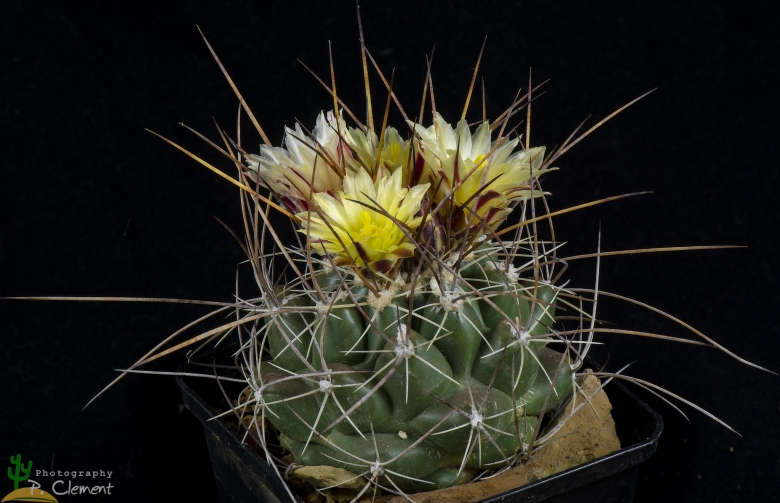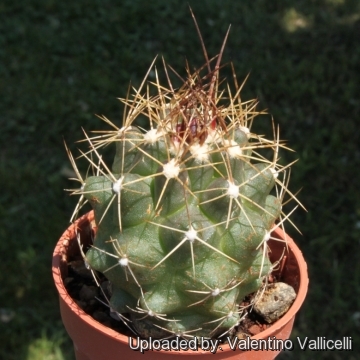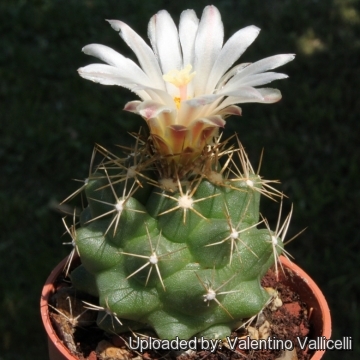Accepted Scientific Name: Thelocactus tulensis (Poselg.) Britton & Rose
Cactaceae (Britton & Rose) 4: 11, fig. 10. 1923 Britton & Rose

Cactus tulensis (Thelocactus tulensis) Photo by: Peiffer Clement
Origin and Habitat: Mexico, San Luis Potosí and Tamaulipas.
Neotype: At KM14 on highway 101 between Tula and the junction at hy. 80 in Tamaulipas
Altitude: 1200 to 1900 metres above sea level
Habitat: Grows in the matorral xerofilo on limestone hills in the Chihuahuan Desert ecoregion.
Synonyms:
See all synonyms of Thelocactus tulensis
back
Accepted name in llifle Database:Thelocactus tulensis (Poselg.) Britton & RoseCactaceae (Britton & Rose) 4: 11, fig. 10. 1923Synonymy: 10
Accepted name in llifle Database:Thelocactus tulensis subs. buekii (E.Klein bis) N.P.TaylorCactaceae Consensus Init. 5: 14. 1998Synonymy: 6
Accepted name in llifle Database:Thelocactus tulensis subs. matudae (Sánchez-Mej. & A.B.Lau) N.P.TaylorCactaceae Consensus Init. 5: 14. 1998Synonymy: 7
Accepted name in llifle Database:Thelocactus tulensis subs. vaskoanus (Halda, Hovorka & Zatloukal) Halda, Kupčák & MalinaActa Mus. Richnov., Sect. Nat. 9(1): 45. 2002Synonymy: 2
back
Description: Thelocactus tulensisSN|1065]]SN|1065]] is a globular and strongly tubercled cactus with larger white to puple flowers. It is a very variable polymorphic species which comprises innumerable geographical forms linked one to each others by populations of plants with intermediate characteristics. Such variations has led to establishment of several unnecessary names for this species.
Habit: Thelocactus tulensisSN|1065]]SN|1065]] is a geophyte succulent plant simple or branching at the top and sides when old, and sometime abundantly cespitose
Stem: Depressed to globose (or somewhat elongated in cultivation), 2,5-25 cm tall, 6-18 in diameter, glaucous green, dark olive green, brownish or magenta and strongly tuberculate.
Ribs: 8 to 13 strongly tuberculate with small distinct connecting ribs between tubercles of the same vertical row.
Tubercles: Plump, very prominent, but quite variable in shape and size, 10-30 mm wide and 12-25 mm tall, conical rounded or somewhat angular in cross section.
Areoles: 2-9 mm long, 2-6 mm wide, 12-35 mm apart, with partially developed grooves,
without nectar secreting glands.
Spines: Acicular, straw coloured, whitish or brownish red, becoming grey with age, evenly distributed on the stem, straight to twisted, flattened.
Central spines: 1 to 7 grey to reddish vertical and straight-projecting, 2-7 cm long.
Radial spines: 4 to 12 radiating straight or more or less recurved, 7-15 mm long.
Root system: Fat underground tap root.
Flowers: Diurnal, silver white, pink or purple with darker mid-stripes, 2,5-5 cm long and 3,5-8 cm wide. Tube very short.
Blooming season: Early summer.
Fruit: Spherical to oblong up to 10 cm in diameter, green to brown opening by basal pore.
Seeds: 1,6-2,7 mm long and o,6-1,7 mm wide, testa cells tabular net patterned with a verrucose surface sculpture.
Subspecies, varieties, forms and cultivars of plants belonging to the Thelocactus tulensis group
- Thelocactus buekii subs. jarmilae Halda & Horáček: smaller size and flowers.
- Thelocactus santaclarensis Halda, Kupčák & Sladk.: bueckii/matudae intermediate form. With rose flowers
 Thelocactus tulensis (Poselg.) Britton & Rose: (ssp. tulensis) Usually branched and with distinct and vertical ribs, round or somewhat pyramidal tubercles, and white flowers; it is the most southern and common, occurring in Tamaulipas and San Luis Potosi at elevations of 1100-1400 m.
Thelocactus tulensis (Poselg.) Britton & Rose: (ssp. tulensis) Usually branched and with distinct and vertical ribs, round or somewhat pyramidal tubercles, and white flowers; it is the most southern and common, occurring in Tamaulipas and San Luis Potosi at elevations of 1100-1400 m. Thelocactus tulensis subs. buekii (E.Klein bis) N.P.Taylor: Usually solitary it has poorly developed or no ribs, more or less pointed, angled tubercles, and magenta flowers; it is centrally located. Distribution: Nuevo Leon at 1200-1800 m.
Thelocactus tulensis subs. buekii (E.Klein bis) N.P.Taylor: Usually solitary it has poorly developed or no ribs, more or less pointed, angled tubercles, and magenta flowers; it is centrally located. Distribution: Nuevo Leon at 1200-1800 m. Thelocactus tulensis subs. matudae (Sánchez-Mej. & A.B.Lau) N.P.Taylor: Usually solitary with indistinct ribs, variable tubercles that are usually conical but somewhat angular in cross section and purplish pink flowers. Distribution: it is the most northern, found in Nuevo Leon at 800-1000 m.
Thelocactus tulensis subs. matudae (Sánchez-Mej. & A.B.Lau) N.P.Taylor: Usually solitary with indistinct ribs, variable tubercles that are usually conical but somewhat angular in cross section and purplish pink flowers. Distribution: it is the most northern, found in Nuevo Leon at 800-1000 m. Thelocactus tulensis subs. matudae f. variegatus hort.
Thelocactus tulensis subs. matudae f. variegatus hort.
Bibliography: Major references and further lectures
1) Edward F. Anderson, Salvador Arias Montes, Nigel P. Taylor, Andrea Cattabriga “Threatened cacti of Mexico” Royal Botanic Gardens, Kew, 1994
2) Edward Anderson “The Cactus family” Timber Press, Incorporated, 2001
3) James Cullen, Sabina G. Knees, H. Suzanne Cubey "The European Garden Flora Flowering Plants: A Manual for the Identification of Plants Cultivated in Europe, Both Out-of-Doors and Under Glass" Cambridge University Press, 11/Aug/2011
4) David R Hunt; Nigel P Taylor; Graham Charles; International Cactaceae Systematics Group. "The New Cactus Lexicon" dh books, 2006
5) N. L. Britton, J. N. Rose “The Cactaceae. Descriptions and Illustrations of Plants of the Cactus Family.” Volume 4, The Carnegie Institution of Washington, Washington 1923,
6) John Borg “Cacti: a gardener's handbook for their identification and cultivation” Blandford P., 1970
7) Hans Hecht “Cacti & succulents” Sterling Pub. Co., 1997
8) Roger Spencer “Horticultural Flora of South-eastern Australia. Volume 2, Flowering Plants: Dicotyledons. Part 1, the Identification of Garden and Cultivated Plants” UNSW Press, 1995
 Thelocactus tulensis, juvenile specimen. (Thelocactus tulensis) Photo by: Valentino Vallicelli
Thelocactus tulensis, juvenile specimen. (Thelocactus tulensis) Photo by: Valentino Vallicelli Thelocactus tulensis, KKR85 Tepeyac, SLP, Mexico. tubercles. The first flower. (Thelocactus tulensis) Photo by: Valentino Vallicelli
Thelocactus tulensis, KKR85 Tepeyac, SLP, Mexico. tubercles. The first flower. (Thelocactus tulensis) Photo by: Valentino VallicelliCultivation and Propagation: Thelocactus tulensisSN|1065]]SN|1065]] is easy to cultivate on its own roots and no special care required, at least given the same care with drainage and watering that is afforded to other Thelocacti.
Growth rate: It is a small growing, but easily flowering species. It offset from the base and can fill a 25 cm pot in just a few years given the best conditions.
Soils: It likes very porous standard cactus mix soil with little organic matter (peat, humus).
Repotting: Repotting every 2-3 years. It will need a pot with sufficient depth to allow the tap root. As it is especially prone to rot under-pot in a smaller container filled with very porous compost. Use pot with good drainage.
Watering: Water regularly in summer, but do not overwater (very wet-sensitively, especially in light of its succulent root system). Its roots are easily lost in pots that stay damp for any length of time. Keep dry with ample airflow in winter. In the rest period no high atmospheric humidity!! Care must be taken with watering as they tends to become swollen and untidy in growth habit if given too much water and shade.
Fertilization: During the growing season enrich the soil using a fertilizer rich in potassium and phosphorous, but poor in nitrogen, because this chemical element doesn’t help the development of succulent plants, making them too soft and full of water.
Hardiness: Reputedly sensitive to frost , but less so if kept on the dry side prior to, and during, cold weather (hardy to -7° C for short periods). However some warmth throughout the year will increase the grower's success (minimum 5° to 8°C during rest season).
Exposition: Outside bright sun, filtered sunlight or afternoon shade, inside it needs bright light, and some direct sun. Subject to sunburn if exposed to direct sun for too long. Tends to bronze in strong light, which encourages flowering and heavy wool and spine production.
Uses: It is an excellent plant for container growing. It always looks good and stays small. It look fine in a cold greenhouse and frame.
Pests & diseases: It may be attractive to a variety of insects, but plants in good condition should be nearly pest-free, particularly if they are grown in a mineral potting-mix, with good exposure and ventilation. Nonetheless, there are several pests to watch for:
- Red spiders: Sensitive to red spider mite. Overhead watering is helpful in controlling mites.
- Mealy bugs: Occasionally mealy bugs they develop aerial into the new growth among the wool with disfiguring results, but the worst types develop underground on the roots and are invisible except by their effects.
- Scales: Scales are rarely a problem.
- Rot: Rot it is only a minor problem with cacti if the plants are watered and “aired” correctly. If they are not, fungicides won't help all that much.
Reproduction: Nearly always from seed, since the plant rarely produces plantlets.












